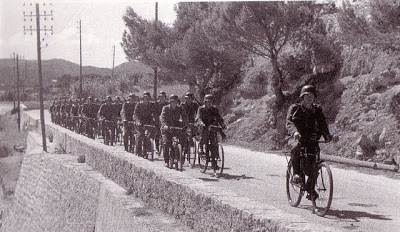
Someone sent me this photo as a gag, saying it represented the Tour de France, 1940. It is, of course, German bicycle infantry, circa 1940. Very funny. But it got me thinking. What if, in some post-disaster scenario, fuel is at a premium? Then bicycle infantry doesn't look like such a bad idea, does it?
Read the material below and give me your reactions.
Mike
III
Here's the citation on bicycle infantry from Wikipedia:
Bicycle infantry are infantry soldiers who maneuver on the battlefield using bicycles. The term dates from the late 19th century, when the "safety bicycle" became popular in Europe, the United States and Australia. Though its use has waned over the years in many armies, it continues to be used in unconventional armies such as militias.
Origins
Numerous experiments were carried out to determine the possible role of bicycles and cycling within military establishments until in 1894 a turning point occurred due to improved resilience of pneumatics and the shorter sturdier construction of the frame.[1] To some extent, bicyclists took over the functions of dragoons, especially as messengers and scouts, substituting for horses in warfare.[2] Bicycle units or detachments were formed at the end of the 19th century by all European armies and the US armed forces.
The United Kingdom employed bicycle troops in militia or territorial units, but not in regular units. In France, several experimental units were created, starting in 1886.[3] They attempted to adopt folding bicycles early on. In the United States, the most extensive experimentation on bicycle units was carried out by a 1st Lieutenant Moss, of the 25th United States Infantry (Colored) (an African American infantry regiment with white officers).
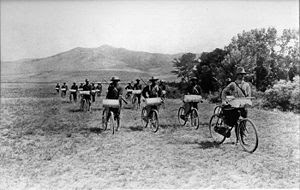 Bicycle Corps at Fort Missoula in 1897.
Bicycle Corps at Fort Missoula in 1897.Using a variety of cycle models, Lt. Moss and his troops carried out extensive bicycle journeys covering between 500 and 1,000 miles (800 to 1,600 km). Late in the 19th century, the United States Army tested the bicycle's suitability for cross-country troop transport. Buffalo Soldiers stationed in Montana rode bicycles across roadless landscapes for hundreds of miles at high speed.
The first known use of the bicycle in combat occurred during the Jameson Raid, in which cyclists carried messages. In the Second Boer War, military cyclists were used primarily as scouts and messengers. One unit patrolled railroad lines on specially constructed tandem bicycles that were fixed to the rails. Several raids were conducted by cycle-mounted infantry on both sides; the most famous unit was the Theron se Verkenningskorps (Theron Reconnaissance Corps) or TVK, a Boer unit led by the scout Daniel Theron, whom British commander Lord Roberts described as "the hardest thorn in the flesh of the British advance." Roberts placed a reward of £1,000 on Theron's head—dead or alive—and dispatched 4,000 soldiers to find and eliminate the TVK.[4]
World Wars
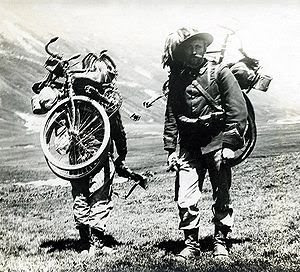 Photo showing Italian Bersaglieri during World War I with bicycles strapped to their backs. 1917.
Photo showing Italian Bersaglieri during World War I with bicycles strapped to their backs. 1917.During World War I, cycle-mounted infantry, scouts, messengers and ambulance carriers were extensively used by all combatants. Italy used bicycles with the Bersaglieri (light infantry units) until the end of the war. German Army Jäger (light infantry) battalions each had a bicycle company (Radfahr-Kompanie) at the outbreak of the war, and additional companies were raised during the war bringing the total to 80 companies, a number of which were formed into eight Radfahr-Bataillonen (bicycle battalions). In its aftermath, the German Army conducted a study on the use of the cycle and published its findings in a report entitled Die Radfahrertruppe[citation needed].
In its 1937 invasion of China, Japan employed some 50,000 bicycle troops. Early in World War II their southern campaign through Malaya en route to capturing Singapore in 1941 was largely dependent on bicycle-riding soldiers. In both efforts bicycles allowed quiet and flexible transport of thousands of troops who were then able to surprise and confuse the defenders. Bicycles also made few demands on the Japanese war machine, needing neither trucks, nor ships to transport them, nor precious petroleum. Using bicycles, the Japanese troops were able to move faster than the withdrawing Allied Forces, often successfully cutting off their retreat. The speed of Japanese advance have also caught Allied Forces defending the main roads by surprise while attacking them from the rear.
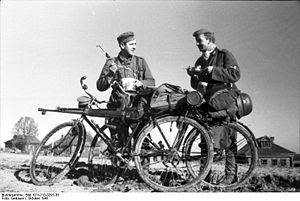 German bicycle infantry on the northern Russian front in 1941
German bicycle infantry on the northern Russian front in 1941The Finnish Army utilized bicycles extensively during the Continuation War and Lapland War. Bicycles were used as a means of transportation in Jaeger Battalions, divisional Light Detachments and regimental organic Jaeger Companies. Bicycle units spearheaded the advances of 1941 against Soviet Union. Especially successful was the 1st Jaeger Brigade which was reinforced with a tank battalion and an anti-tank battalion, providing rapid movement through limited road network. During winter time these units, like the rest of the infantry, switched to skis.
Within 1942-1944 bicycles were also added to regimental equipment pools. During the Summer 1944 battles against the Soviet Union, bicycles provided quick mobility for reserves and counter-attacks. In Autumn 1944 bicycle troops of the Jaeger Brigade spearheaded the Finnish advance through Lapland against the Germans; tanks had to be left behind due to the German destruction of the Finnish road network.
The hastily assembled German Volksgrenadier divisions had a battalion of bicycle infantry, to have some mobile reserve.
Allied use of the bicycle in World War II was limited, but included supplying folding bicycles to paratroopers and to messengers behind friendly lines. The term, "bomber bikes" came into use during this period, as US forces dropped bicycles out of planes to reach troops behind enemy lines.
By 1939, the Swedish army operated six bicycle infantry regiments. They were equipped with domestically produced Swedish military bicycles. Most common was the m/42, an upright, one-speed roadster produced by several large Swedish bicycle manufacturers. These regiments were decommissioned between 1948 and 1952, and the bicycles remained for general use in the Army, or transferred to the Home Guard. Beginning in the 1970s, the Army began to sell these as military surplus. They became very popular as cheap and low-maintenance transportation, especially among students. Responding to its popularity and limited supply, an unrelated company, Kronan, began to produce a modernized version of the m/42 in 1997.
Later uses
Although much used in World War I, bicycles were largely superseded by motorized transport in more modern armies. In the past few decades, however, they have taken on a new life as a "weapon of the people" in guerrilla conflicts and unconventional warfare, where the cycle's ability to carry large, about 400 lb (180 kg), loads of supplies at the speed of a pedestrian make it vastly useful for lightly-equipped forces. For many years the Viet Cong and North Vietnamese Army used bicycles to ferry supplies down the "Ho Chi Minh Trail", avoiding the repeated attacks of United States and Allied bombing raids. When heavily loaded with supplies such as sacks of rice, these bicycles were seldom rideable, but were pushed by a tender walking alongside. With especially bulky cargo, tenders sometimes attached bamboo poles to the bike for tiller-like steering (this method can still be seen practiced in China today). Vietnamese "cargo bikes" were rebuilt in jungle workshops with reinforced frames to carry heavy loads over all terrain.
Modern times
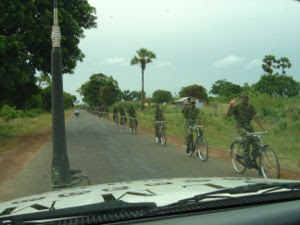 LTTE bicycle infantry platoon north of Killinochi in 2004
LTTE bicycle infantry platoon north of Killinochi in 2004Bicycles continue in military use today, primarily as an easy alternative for transport on long flightlines. The use of the cycle as an infantry transport tool continued into the 21st century with the Swiss Army's Bicycle Regiment, which maintained drills for infantry movement and attack until 2001, when the decision was made to phase the unit out.[5]
The LTTE Tamil Tigers made use of bicycle mobility in the fighting in Sri Lanka. The Sri Lankan army also has a bicycle unit. They are mainly stationed and deployed in high security zones in the capital city Colombo. The theory and the basis of their usage is still not well known.
See also
Paratrooper folding Tactical Mountain Bicycle
Army Cyclist Corps
References
1. Leiser 10
2. Leiser 11-16
3. Leiser 11
4. "Danie Theron" (html). http://www.instinsky.de/Boer_War/Danie_Theron/danie_theron.html. Retrieved on 2007-10-07.
5. Doole, Claire, End of road for Swiss army cyclists, BBC News, http://news.bbc.co.uk/1/hi/world/europe/1325485.stm, retrieved on 2008-02-05
Bibliography
Leiser Rolf (sup.) (1991). Hundert Jahre Radfahrer-Truppe (100 Years of Bicycle Troops). Bern, Switzerland: Bundesamt für Mechanisierte u. Leichte Truppen (Federal Office for Mechanized and Light Troops).
Fitzpatrick, Jim (1998). The Bicycle In Wartime: An Illustrated History. Washington, DC: Brassey's Inc.. ISBN 1-57488-157-4.
Ekström, Gert; Husberg, Ola (2001). Älskade cykel (1st ed.). Bokförlaget Prisma. ISBN 91-518-3906-7.
Retrieved from "http://en.wikipedia.org/wiki/Bicycle_infantry"
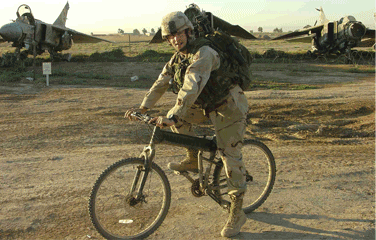
Montague Bikes is a U.S. manufacturer that makes folding bicycles for civilian and military customers. Formed in 1987 by David Montague while still in graduate school at the Massachusetts Institute of Technology, the first bicycle designed by Montague was called the "Montague BiFrame" for its patented Concentrus system. This system, which unites the two parts of the frame with concentric seat tubes, one nested inside the other, allows a bike with a full-size frame to fold in half while maintaining the structural integrity of the design.
In 1997, Montague received a two-year grant from the Defense Advanced Research Projects Agency (DARPA), who recognized the importance of folding bikes, to work with the United States Marines in developing the Tactical Electric No Signature (TENS) Mountain bike. For this project Montague developed a new folding design, enabling the bike to fold faster for Paratrooper exit from military aircraft while also increasing its load bearing capacity. This gave rise to the Paratrooper folding Tactical Mountain Bicycle, Montague’s non-electric Military Mountain Bike. It costs around US $695.00. -- Wikipedia.
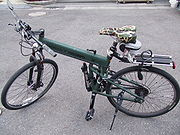 Montague Paratrooper Bike.
Montague Paratrooper Bike.The following Montague-produced diagram demonstrates the efficiency of Bike/Electric Bike Infantry:
System: Infantry -- Load Cap. = 50 lbs. Daily Range = 25 miles. Speed = 3 mph. Fuel per Day = 0 Food per Day = 3 lbs. Water per day = 24 lbs.
System: Bicycle Infantry -- Load Cap. = 50 lbs. Daily Range = 75 miles. Speed = 10 mph. Fuel per Day = 0 Food per Day = 3 lbs. Water per day = 24 lbs.
System: Horse Cavalry -- Load Cap. = 100 lbs. Daily Range = 100 miles. Speed = 15 mph. Fuel per Day = 40# hay Food per Day = 3 lbs. Water per day = 164 lbs.
System: Electric Bicycle Infantry -- Load Cap. = 50 lbs. Daily Range = 100 miles. Speed = 15 mph. Fuel per Day = Electric Charge Station. Food per Day = 3 lbs. Water per day = 24 lbs.
System: Morocycle Infantry -- Load Cap. = 100 lbs. Daily Range = 300 miles. Speed = 40 mph. Fuel per Day = 55# gasoline. Food per Day = 3 lbs. Water per day = 24 lbs.
System: Medium truck -- Load Cap. = 10,000 lbs. Daily Range = 400 miles. Speed = 40 mph. Fuel per Day = 350# diesel. Food per Day = 6 lbs. Water per day = 48 lbs.
System: APC -- Load Cap. = 10,000 lbs. Daily Range = 300 miles. Speed = 35 mph. Fuel per Day = 665# diesel. Food per Day = 6 lbs. Water per day = 48 lbs.
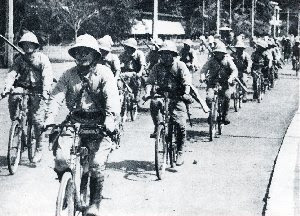
Japanese bicycle troops entering Batavia, Java Island, Dutch East Indies, March 8th 1942
13 comments:
Take your force multipliers where you can get them when you can afford them. Bikes are affordable by self-supplied militiamen.
I want an electric folding paratrooper bicycle.
Cheers.
Montague Paratrooper Bike in pedal-power trim seems like a bargain at $699 retail when compared to the $4400 electric version. $3500 buys a lot of good gear, even through your supply Sgt.
Cheers.
And let us not forget the NVA moving their supplies on bicycles. Technically they weren't "bicycle infantry," but as a means of transport of both personnel and supplies the bicycle is unsurpassed in terms of cost and maintenance.
Neat article: With respect to horse cavalry ["System: Horse Cavalry -- Load Cap. = 100 lbs. Daily Range = 100 miles. Speed = 15 mph. Fuel per Day = 40# hay Food per Day = 3 lbs. Water per day = 164 lbs."
The daily range of 100 miles, speed of 15 mph and lack of a grain requirement are misleading.
On the march, day-in, day-out, horses only move at a fast walk, with short periods of trot & cantor, producing an average speed, over time, of little more than 4-5 mph. Horses need a day of complete rest out of six. or the horses wear down too rapidly.
Horses cannot maintain a 15mph pace for any length of time. While thoroughbreds can indeed reach race speeds of above 30 mph, these are short duration race speeds; the 15 mph speed is a run speed for an encumbered cavalry horse...
Also, horses need to graze morning and/or evening, limiting the hours in a day that a horse-mounted unit can be on the march. Horses will not graze in the dark in strange territory, further limiting march-time - which limits daily march distance. 100 miles per day is not realistic. 40 miles per day is a realistic planning actor.
Historically, infantry units are capable of out-marching large horse formations over extended distances...
Most importantly, horses require 8-10 pounds of grain, daily, to maintain strength when working hard (e.g. cavalry operations). Mere grass, hay or fodder will not suffice. (We call such units "The Horse Breakers."
Source: Alexander of Macedon and the Logistics of the Macedonian Army" (a great and instructive read).
The Wretched dog.
Couple things:
1: As with any other bit of equipment, you get what you pay for. A cheap bike from Wally World will weigh around 35 pounds, which you will have to propel along with the rest of your gear. Steel is an OK material for frames, fasteners and cables. Everything else should be aluminum. Especially the rims: less rotating weight (that's the resistance you feel when you start to pedal), and alloy rims brake better than steel when they're wet.
2: When you buy a bike, you're really buying the frame/fork. Everything else can be swapped out as your finances permit.
2a: Most of the brakes and transmission will be made by Shimano. The only difference between the high-end and the low end are the materials used. Functionally, they're identical, and can be replaced as you need to.
3: Hubs. This is a 'mission critical' area. If the bike you're looking at does not have one-piece alloy hubs, don't buy it.
4: Tires. They come in two basic flavors, folding and non-folding. The folding ones use kevlar as the bead reinforcement, the others use steel wire. Besides adding rotating weight out near the rim (which is bad), they're more difficult than the folders to add to your pack. What? You were gonna wander around on the pointy end without at least one spare tire? Protip: usually when you gash the sidewall the tire is toast, however, you can use US paper money as a temporary boot so you can partially inflate the tire until you can get your hands on a replacement. High rag content paper is pretty strong stuff.
5: Weight distribution. Say you've got 60 pounds worth of guns, ammo and gear you want to move around. The more stuff you load on the bike, the more sluggish it will feel. You can easily put half that weight into a backpack, and your ride will still feel responsive under your feet, and you won't put as much wear on the brake pads to stop, even though the total weight of you/bike/gear is the same.
Part the Second:
Most of my biking was as an amateur racer, and we have (had) a concept called Stupid Light, and no, it's not complementary. There's no such thing as a component that weighs zero, so you must spend your grams wisely. For instance, the drop down handlebars on a race bike need to weigh at least 240 grams, unless you think that having them suddenly snap and obligating you to use your face as a brake is a good idea.
Wretched Dog:
Excellent critique of cavalry/horse mounted infantry but you left out one critical demerit. Horse cavalry requires horse holders when going into action, 1 for 4 is the usual percentage. Bedford Forrest's men, when critically pressed, would go to 6 or 8 per horse holder but found that too many mounts had bolted when they returned. There is a limit to how many critters can be controlled by one man. (And remember, the horse holders are often the guys who are ill, or lightly wounded, thus making it tougher on them to control the mounts.)
So whatever force you are able to project with horse cavalry, it will be down 25% when it meets the enemy.
Bikes, though not as stout as horses, do not have a tendency to bolt under fire.
On the other hand, if you're in retrograde, you cannot lead a fallen comrade's bicycle off by the reins.
Everything's a trade off.
I've long been an advocate of the mountain bike for the thinking patriot. Clearly handy for use in bad times, but also useful prior to then for scouting and general exploration - you'll just look like some dude on a bike. They can be very handy for near silent travel at a much better pace than walking. Get out your map and explore - don't overlook the major power line cuts as an alternative to roads. These bikes have merit.
"On the other hand, if you're in retrograde, you cannot lead a fallen comrade's bicycle off by the reins."
On a good trail or road, with an unloaded bike, you can grab the handlebar neck for both pulling and steering. It's called "ghost riding". That's how you get a new bike home from a thrift store.
A frame extension called Xtracycle can have rails added to carry 2 unloaded bicycles as sidesaddle next to the rear wheel.
Wheelbase extension of about 15" makes cobblstones harmless at high speeds, where a regular bicycle skitters all over dry cobblestones.
Xtracycle has an expensive motor/battery option available.
http://www.xtracycle.com
Cheers.
thedweeze,
Good points. My "knowledge" might be too old so perhaps you will set me straight, but I disagree with your prescription of alloy rims in order to reduce weight & rotational inertia. When I rode on the street a lot, decades ago, and had to cross railroad tracks, I potato-chipped my alloy rims and got disgusted with alloy rims real fast. Steel rims held up to shocks in the road a lot better than alloy. I would recommend steel there, unless alloys are that much stronger now, which they might well be. Interesting point about alloy braking better when wet.
There are also bicycle trailers out there. I have a BOB trailer which is very nice for loads up to 60 pounds. While these trailers have limited durability (in an attempt to keep them lightweight), they can take as much abuse as the bicycle towing them can.
About 10 years ago, just to see what I was capable of, I loaded my touring bike's four panniers with ~60 lbs of gear and my BOB trailer with 50+ lbs and rode 200 miles on a 3-day weekend. I wasn't setting any speed records but I was in considerably better shape than if I'd "hoofed-it".
TCM
Anon: What you're referring to is a matter of technique, rather than any inherent strength of material. When you approach train tracks, a curb, a piece of lumber in the road, whatever, there are some things you can control, and others you cannot, such as the total weight of you and the bike. That means a certain amount of mass heading towards a deformation in the roadway. There are only a few things that you can do to attenuate this. Note that I said 'attenuate', not remove them from the equation. First, of course would be to slow down, that is stretch the shock impulse over a longer span of time. You and I can easily imagine a situation where slowing down would spare your wheels, but would cost you your life/liberty. Then there are fatter tires, which have a greater volume of air to absorb the shock. There are limits to this, as there are limits to what any rim material can take before you get the dreaded Taco.
The idea here is to spread the shock impulse over as great a span of time as possible, and to give your bike the greatest opportunity to deal with it. As I mentioned before, I'm a road warrior, and I have never had tires wider than 26mm. I also build my own wheels, and I can tell you how much each bit costs, and I can also tell you of my reluctance to spend money to replace said bits. :)
As I said when I started, this is a matter of technique: when you see the hole/rails/branch/curb coming up, you need to take your butt off the saddle, so that the bike can pivot around the bottom bracket (the small axle to which the cranks/pedals are attached). A shock impulse that will destroy a wheel in several hundreths of a second can be shrugged off if that impulse is spread over several tenths of a second. Having your hands and feet as the sole contact points during a bump will allow the bike to rock forward and back without damaging the wheels. Then there's the 'bunny hop', where you again take your butt off the saddle, but instead of staying still, you wait until the last possible instant and jump upward, pulling the bike upward with you *over* the obstacle. Be prepared to fall off the first few times until you get it right. Pain, unfortunately, is the best teacher here. I spent the better part of a decade as a messenger in NYC, and like my brethren, I completely ignored the traffic laws, but unlike many of them, I was never ticketed by the NYPD, despite their best efforts. Cars, scooters, whatever, it didn't matter. Their advantage in straight line speed can't compare to the lateral agility of a bicycle in traffic. Not to mention the 'inspiration' that having an unregistered *item* in my bag gave me. Heh.
pdxr13: As to your electric folding bike, let me tell you one of my Rules Of Cycling:
It cannot break if it isn't there. I raced from 1975 to the early '90's, and I managed, at one time or another, to break/bend or otherwise render useless every part of a bike.
Also, here's one of my road racing rules:
If it does not make the bike go faster, it doesn't belong there. That includes the highest quality brakes/pads that you can afford: being able to scrub 5-10mph off is frequently the difference between a clean corner and a broken clavicle. Trust me, I've got one of those, and those slinky way-cool Dia-Compe aeros got sold off and replaced with a proper set of Campagnolo Nuovo Records while I was healing.
Post a Comment